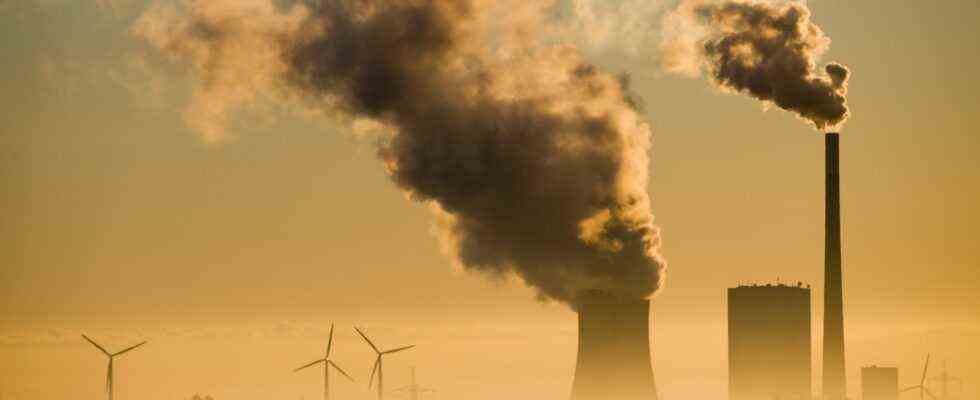background
As of: 07/29/2021 8:22 am
Certificates for CO2 emissions have been traded in Europe for many years, and the system is now to be expanded. However, there are still some question marks behind the Brussels plans.
The legislative package is over a thousand pages thick, after all, it describes the restructuring of Europe’s way of life and economy in order to achieve the EU climate targets. This is actually about two things, says the responsible Vice President of the EU Commission, Frans Timmermans, namely to make the emission of carbon dioxide more expensive and to reward the abandonment of fossil fuels: “We price CO2 less to give the incentive And we reward decarbonization to provide impetus for innovation, customization, and the launch of new technologies that help us achieve our goals. ”
Polluters have to pay
Giving carbon dioxide a price: the idea is not new. Emissions credits have been traded in the European Union for 16 years. Those who can reduce CO2 at low cost offer surplus certificates. Those who find it harder to do so will buy them. Emissions trading asks the polluters of climate-damaging greenhouse gases to pay – and provides impetus to emit less CO2. Politicians specify how much emissions should be reduced in order to achieve the climate targets – by limiting the total number of certificates and steadily reducing the amount of credits in circulation. The market does the rest, explains Sebastian Rausch from the Center for European Economic Research (ZEW).
“Emissions should be avoided where it is cheapest,” says the expert. “But it is practically impossible for a government to have this information at its disposal and thus be able to organize direct support in such a way that there are no false incentives.” An emissions trading system, on the other hand, creates a market in which a price for CO2 arises through supply and demand, says Rausch: “This price has a steering effect on the decisions of households and companies that themselves have the information to decide in which Scope, it pays to reduce emissions. ”
Prices are likely to rise
In the EU, 11,000 companies have to show a certificate for every tonne of carbon dioxide emitted, in Germany around 1,850 plants are affected: power plants, cement factories, refineries, steel works. Since 2012, intra-European air traffic has also been included. Overall, emissions trading (ETS) covers around 40 percent of EU greenhouse gas emissions. This works: The particularly climate-damaging coal-based power generation has become uneconomical in many places. According to the European Environment Agency, emissions fell by 24 percent by 2019 compared to 1990 levels.
Sebastian Rausch from ZEW says a successful model that the EU Commission wants to expand: “The Commission’s proposals provide for the number of certificates in the existing emissions trading system to be steadily reduced from year to year in addition to a one-off downward adjustment an increased factor. This shortage of supply means that the price of emission allowances will rise. ” In order not to put EU companies at a disadvantage in global competition, most of the certificates were initially given away. The steel industry is allocated around 80 percent of the emission rights and purchases the rest.
But that should end now. Germany’s largest steel manufacturer, Thyssenkrupp in Duisburg, fears the planned changes will have disadvantages compared to non-European competition: “Above all, the massive reduction in free certificates as part of the European emissions trading would deprive us of substantial funds that we would use for investments in climate protection and thus for financing The way in which an as yet untested CO2 border adjustment linked to the ETS can provide a reliable compensation is still completely unclear at the same time, “a statement said.
How much are petrol and heating oil becoming more expensive?
There are also many question marks behind the Commission’s plan to introduce a second emissions trading scheme for transport and buildings. That would drive up the cost of gasoline and heating oil – even if the entry price is supposed to be low in 2026. We are talking about 25 euros per tonne of CO2, which would correspond to an increase of 6.6 cents per liter of diesel. Even later, prices will not rise so much that they create the necessary incentives to achieve the German climate targets, emphasizes the director of the Agora Verkehrswende think tank, Christian Hochfeld: “Just as the European emissions trading scheme is designed for the transport sector, it can be for Germany will not become the lead instrument, we need fleet limits and other fiscal instruments that will improve the transport transition and the achievement of the 2030 climate targets. ”
The market alone will therefore not fix it, which is why politicians should set guidelines. The Commission is proposing to tighten the CO2 limit values for new cars until they are no longer allowed to blow CO2 into the air in 2035. Jekaterina Boening from the think tank Transport & Environment also wants “a policy mix of regulatory law such as fleet limits and regulation for the charging infrastructure as well as a colorful bouquet of pricing instruments”. This includes not only the CO2 price, but also the vehicle tax and company car taxation, according to Boening.
That goes to the nitty-gritty. In the Bundestag election campaign, the candidates for the Chancellery are basically committed to more climate protection – so far, they have not made any concrete statements about the proposals of the EU Commission. Maybe that will come: the discussion about Brussels’ thousand-page bill has only just begun.

